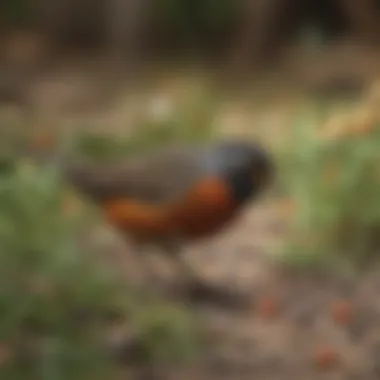Exploring the Eating Habits of American Robins


Intro
When it comes to the backyard wildlife we encourage, few birds are as beloved as the American robin. Their characteristic red breasts and cheerful songs draw attention and admiration alike. However, understanding their feeding habits is essential for those looking to attract these vibrant creatures to their gardens. One common question among many bird enthusiasts is whether or not robins eat bird seed. More than just a simple appetite query, this topic touches on various aspects of the robins’ diet and their preferred food sources.
As we delve deeper into this subject, we will explore robins’ natural dietary preferences, the nutritional value of different food options, and what it takes to entice these birds to visit your space. This exploration aims to enrich not only your understanding but also your interactions with these charming birds.
Natural Diet of American Robins
American robins are known to feast primarily on insects, earthworms, and fruits. In particular, during the warmer months, an adult robin might consume a staggering amount of worms, dining on as many as 40 in one sitting. This voracious appetite for invertebrates helps control pest populations in gardens. When the weather cools down, robins shift their focus to fruits such as berries and cherries.
Interestingly, it is during the migration period that robins might experiment with different food sources, including seeds. This seasonal adjustment highlights their adaptability as they seek sustenance based on availability. "Robins prefer high-protein sources over seeds, particularly in their breeding season when their energy needs are at a peak."
The Role of Bird Seed
Though soil worms and ripe berries are the staples of a robin’s diet, the allure of bird seed can’t be entirely dismissed. When times get tough in winter, robins are known to peck at seeds, specifically smaller varieties like sunflower hearts. However, they aren't particularly optimized to extract nourishment from hard, tough seeds like those found in bird feeders designed for finches.
Nutritional Aspects of Bird Seed
Bird seeds generally offer less protein and moisture compared to the fresh foods robins instinctively seek. While seeds can provide some energy, their nutritional profile often falls short when compared to juicy earthworms or nutrient-dense fruits. Therefore, if you're thinking about filling your yard with feeders, it’s crucial to understand that while robins might snack on seeds occasionally, they aren't the core of their diet.
- Benefits of feeding robins:
- Limitations of bird seeds for robins:
- Helps in observing their lively behaviors.
- Can offer an alternative food source during scarce periods.
- Lack of complete nutritional value for their needs.
- Not every seed is appealing to robins, limiting their interest.
Tips for Attracting Robins to Your Garden
If your aim is to draw robins into your outdoor space, consider strategies that prioritize their natural preferences:
- Incorporate Native Plants: Native plants can offer a buffet of fruits and insects that robins are likely to relish.
- Provide Water Sources: Ensure there are bird baths or water features, as hydration is essential, especially in hotter months.
- Minimize Pest Control: Letting some insects thrive can create a healthier habitat where robins can find their main meal, rather than just munching on seeds.
In wrapping up this section, it’s essential to recognize the beauty in providing food tailored to the natural inclinations of robins. With richer sources of energy and nutrition, these birds will not just visit; they'll make your garden their home.
Understanding the American Robin
The American robin is more than just a beautiful bird seen flitting about in backyards and parks. Understanding this common but fascinating creature provides insights into its feeding habits, migration patterns, and overall place in the ecosystem. The robin's behavior and diet intermingle intimately with its environment, making it a vital subject of study for bird enthusiasts and gardeners alike.
Robins are adaptable, often seen as harbingers of spring, but there's much more than meets the eye when considering their impact on biodiversity. Their choice of food affects plant propagation, pest control, and even the overall health of the ecosystems in which they thrive. When one comprehends the fundamentals of the robin's taxonomy and distribution, it sets the stage for deeper discussions about what they eat and why food sources, such as bird seed, play a role in their diet.
With that in mind, delving into the details of their classification and habitat is essential. Understanding where robins are found and how they fit into the avian family tree can help paint a richer picture of their feeding preferences and behavioral patterns.
Taxonomy and Distribution
The American robin, scientifically known as Turdus migratorius, belongs to the thrush family, which comprises various songbirds. Its classification gives us an essential context for understanding its role in the animal kingdom. As one of the most widely distributed birds in North America, robin populations can be found from southern Canada to northern Mexico.
Robins inhabit diverse environments, including urban areas, woodlands, and gardens. These adaptable birds are often seen in close proximity to humans, likely due to their opportunistic feeding habits. Recognizing the areas where robins thrive can help homeowners improve their gardens to attract these birds, creating a harmonious balance between human habitats and natural wildlife.
Physical Characteristics
American robins are easily recognizable thanks to their distinct appearance. They flaunt a round body adorned with a reddish-orange breast, contrasting with their darker wings and head.
Adults typically measure about 9 to 11 inches in length, with an impressive wingspan of about 12 to 16 inches. A keen observer might note subtle variations in their plumage, influenced by the seasons or their geographical location. Their yellow-orange beaks are not just for show; they serve an important purpose in foraging. Equipped with excellent vision, robins can spot insects and berries from a distance and can often be seen hopping on the ground, searching for hidden delicacies beneath the surface.
In addition to their striking appearance, American robins exhibit different behaviors based on the time of year and environment. Their plumage tends to appear duller in the winter months, possibly as an adaptation against predators. Understanding these physical traits sets the ground for comprehending how they relate to their feeding habits and preferences, tying back beautifully to the article's central theme.


"Robins are not just birds but indicators of ecological health, reminding us of the delicate balance that exists in our surroundings."
Through understanding their taxonomy and characteristics, we can delve into the dietary preferences of robins, which will reveal their sometimes surprising relationship with bird seed.
Dietary Preferences of Robins
The dietary habits of American robins are not merely a matter of taste but are central to their survival. Understanding what these birds favor when it comes to food can enrich the birdwatching experience and help homeowners create environments that attract them. Robins possess an omnivorous diet, which means they seek a variety of food sources throughout the year. The diversity in their diet plays a crucial role in their health and breeding success.
When evaluating the feeding habits of robins, three key components stand out: natural diet components, pest control via insects, and the seasonal availability of fruits. This section will provide a window into the complexities of their preferences, emphasizing how these food choices impact their behavior and overall ecosystem.
Natural Diet Components
Robins have a few intrinsic favorites in their natural diet that extend beyond expectations. The predominant components include:
- Invertebrates: Worms and other soil-dwelling critters are especially prevalent during spring and summer.
- Fruits and berries: This is a staple during the late summer and into fall.
- Seeds: Although they do not primarily seek out seed, certain species can be opportunistic.
The variety in their diet is not just pleasing; it actively shapes their behaviors and habits. Robins may adjust their foraging strategies according to the availability of food sources. This adaptability indicates an innate connection to the seasons and local ecosystems.
Insects and Invertebrates
A robin's penchant for insects and invertebrates not only showcases their dietary preferences but highlights their role as pest controllers within the garden and broader landscape. In spring and summer, these birds particularly feast on:
- Earthworms: A favorite among robins, particularly after rainfall when these worms come to the surface.
- Grubs: Found below the soil, these provide necessary protein for nesting mothers.
- Beetles and caterpillars: Seasonal delights that spark active foraging sessions for robins.
These insects offer a vital protein boost, especially during the breeding season when robins require more energy and nutrition. Their hunting method usually involves a keen eye and quick movements, capturing soundly the crawling treasures that lie just beneath the surface. Gardeners often appreciate their bug-hunting skills, which can keep pests at bay.
Fruits and Berries
As summer gives way to autumn, the focus of robins shifts, and they become enthusiasts of fruits and berries. They are particularly attracted to:
- Mulberries: Juicy and sweet, they can attract a crowd of robins when ripe.
- Cherries: A favorite, though often subject to competition from other birds.
- Elderberries: Known for attracting birds with their clusters of dark berries.
Fruits not only keep the energy levels high but also provide hydration. Observing robins indulging in the plentiful berries can be a delightful sight during late summer and into fall. Their foraging plays an important role in seed dispersal; as they consume fruits, they also help in spreading seeds through their droppings, contributing to the growth of new plants.
"Robins are more than mere garden visitors; their eating habits serve the ecosystem by controlling insects and promoting plant growth."
Encouraging fruits and berry-producing plants in your garden can help maintain a welcoming habitat for robins, benefiting both the birds and your landscape. By understanding their feeding preferences, you can foster a rich environment that appreciates these remarkable avian neighbors.
Robins and Bird Seed
The relationship between robins and bird seed is a topic that raises eyebrows for many bird watchers, especially those keen on observing these charming creatures in their backyards. Understanding whether robins are drawn to bird seed can significantly influence how we set out to attract them. It's not just about tossing some seed out and hoping for the best; it's about recognizing what truly piques a robin's interest.
Are Robins Attracted to Seed?
While many assume that robins will flock to any available seed, their attraction to it is somewhat nuanced. Robins are primarily fruit and insect eaters. Seeds, particularly those found in mixed bird seed blends, do not tend to be the first choice for these songbirds. That isn’t to say they completely snub their nose at seeds. In fact, certain types of seeds, like sunflower seeds, can catch their attention. However, it’s important to bear in mind their natural inclinations.
"Robins are often more captivated by juicy berries than by a pile of seeds. They’re frugivores at heart, thriving during the berry-laden months."
Watching robins during berry season can reveal a great deal. These birds become so engrossed in snacking on the fruits of nature that they often overlook feeders. Therefore, if you're looking to attract robins to your yard, it's pivotal to offer a variety of food sources, where berry shrubs are a game-changer.
Types of Seed Available
If you still want to go the seed route, there are particular kinds that could resonate better with robins:
- Sunflower Seeds: While they’re not a staple, some robins will nibble on them. The seeds might pique their curiosity, especially during migration.
- Safflower Seeds: These can sometimes draw birds that might not typically be seed enthusiasts.
- Mixed Bird Seed: A decent option, but only a few robins may partake among a flock of other species.
Keep in mind that seeds like millet are often left untouched. Robins have taste preferences that lean toward the sweet and juicy, which is why piles of seeds may not be enticing enough to draw them in.


Comparative Nutritional Value
The nutritional aspects of bird seed versus the robins’ natural diet are striking. Seeds tend to be lower in protein and higher in carbohydrates when compared with the insects and fruits that robins typically seek. For instance:
- Insects: High in protein and fat, insects are incredibly valuable for robins, especially during nesting season when they need to feed their chicks.
- Fruits: Berries provide sugars, vitamins, and moisture, making them a need-to-have in a robin's diet.
- Bird Seed: Even the best seed mixes just can't match up in terms of nutrient density when compared to what robins usually prefer.
When you put bird seed on the table, you might be providing a snack, but it's hardly a feast. As responsible bird enthusiasts, understanding these differences helps in making informed decisions on how to create an attractive environment for these birds.
Seasonal Behavioral Changes
Seasonal changes greatly influence the feeding habits of the American robin. Understanding these shifts is crucial for identifying how these birds adapt their diets in relation to food availability and environmental conditions. As seasons change, so do their preferences, and by comprehending this dynamic, gardeners can create better environments to attract robins throughout the year.
Spring and Summer Diets
During spring and summer, robins focus on an array of foods primarily to support breeding and raising fledglings. The warmer months see a surge in insect populations, providing a plentiful source of protein. Common insects that robins feast on include caterpillars, beetles, and grasshoppers. The ability of robins to adapt their diet to chase down elusive insects allows them to thrive in rich, vibrant ecosystems.
Robins also turn to fruits and berries that ripen in these warmer months. Favorites like raspberries and blackberries become important nutritional sources. These fruits provide energy and hydration, essential for the demanding activity of raising young birds. Interestingly, robins are known to forage more aggressively in spring as they seek out the best patches of fruit and insect life, often sharing these spots but competing fiercely for access.
- Protein Sources:
- Fruits:
- Caterpillars
- Grasshoppers
- Beetles
- Raspberries
- Blackberries
In terms of feeding habits, robins are quite adaptable and will often visit backyard gardens to scout for these foods, making gardens that offer a variety of native plants a hotspot for them. Providing water sources, like shallow bee baths, can further enhance their presence around homes.
Autumn and Winter Adaptations
As autumn rolls around, robins start to change their feeding strategies. Insects become scarce, prompting robins to shift from protein-heavy diets to rely more on fruits and berries. This transition often brings them to areas where wild fruits, such as crabapples and hackberries, are abundant. The ability to adapt to less familiar food sources during winter showcases robins' remarkable resilience.
During the colder months, robins may also be seen flitting about in flocks. This social behavior is often a survival strategy that enables them to locate food more efficiently. They employ various foraging techniques, such as hopping through leaf litter to uncover any remaining insects or simply waiting for suitable fruits to become accessible in gardens and trees.
In regions where winters are particularly harsh, migratory behavior may kick in, prompting some robins to seek warmer climates where food is still readily available. This adaptability in feeding strategies helps ensure their survival, allowing them to thrive despite shifting seasons.
"The adaptability of robins in changing their diets with the seasons underscores their resilience as a species."
To enrich their winter diets, homeowners can take simple steps to ensure robins find suitable food sources, like planting berry-bearing shrubs or leaving fallen fruits on the ground. A diverse garden can turn into a crucial sustenance hub for these birds during the winter months.
Attracting Robins to Your Garden
Bringing American robins into your garden isn't just a pleasant sight; it can enrich the local ecosystem and enhance your gardening experience. These birds are not only beautiful to watch, but they also play a significant role in controlling insect populations and spreading seeds from berries and fruits. Understanding the right ways to attract robins can make your outdoor space a vibrant habitat, beneficial both for you and the birds.
Choosing the Right Plants
Selecting suitable plants is fundamental if you want to invite robins into your garden. Many homeowners mistakenly think that any plant will suffice, but robins have specific preferences. They are particularly fond of berries such as blackberries, blueberries, and holly berries. Also, consider incorporating native plants. These are usually well-adapted to the local environment and provide not only nourishment but also shelter. For instance, dogwood and serviceberry bushes are often favorites. Moreover, flowering plants like dandelions can attract the insects that robins love to eat.
- Native plants: Choose plants that are local to your area.
- Berries and fruits: Integrate berry bushes and fruit trees to provide food.
- Insect-attracting flowers: Opt for flowering species that draw in insects for robins to feast on.
By planting these varieties, you create an inviting space for robins while also enhancing the biodiversity of your garden.
Creating a Suitable Feeding Environment
Creating an ideal environment is another key area of focus. Robins prefer areas that have both open spaces for foraging and cover for safety. This means incorporating a blend of plant heights and densities.
- Open ground: Ensure there are clear areas where robins can hunt for insects.
- Shrubs and trees: Provide nearby perches that offer safety from predators.
- Water sources: A shallow birdbath can serve as a critical water source, especially during dry spells.


By arranging your garden in this way, you can ensure that robins have everything they need to thrive. They will feel secure, making your garden a regular stopover.
Supplemental Feeding Strategies
While robins primarily hunt for natural sources of food, supplementary feeding can effectively entice them, especially during winter months when food is scarce. Though seeds are not their first choice, certain ones can be beneficial. Consider offering:
- Mealworms: These are particularly attractive to robins and can be presented in a shallow dish.
- Fruits: Chopped apples or raisins can provide an easy food source.
- Specialty bird seed: If you still want to offer seed, look for blends that include ingredients favored by robins, such as dried fruits or mealworms.
Implementing these supplemental feeding strategies can make your garden a go-to feast spot for robins, especially during the cooler months.
A little planning and thoughtfulness in your gardening choices can pave the way for a thriving robin presence in your garden, leading to a rich and lively ecosystem right outside your window.
Common Misconceptions
When it comes to American robins, a host of misunderstandings frequently strolls around, often overshadowing their natural habits and preferences. This article delves into common misconceptions surrounding these vibrant birds to shed light on their actual feeding behaviors and dietary inclinations. Understanding these myths is vital not only for bird enthusiasts but also for gardeners looking to attract robins effectively. Nearly every corner of avian observation has its fair share of folklore, and robins are no exception.
Myths About Seed Feeding
One prevalent myth suggests that robins primarily feast on seeds, a notion that can easily mislead those trying to lure these birds to their gardens. While it's true that robins may peck at seeds from time to time, claiming this as a staple of their diet is much like saying a chef relies solely on salt to create a dish.
In truth, American robins are primarily insectivores and frugivores, meaning they chuckle at the thought of munching on seeds when delicious berries and tender insects are in abundance. For example, during the summer, you’ll likely find them enjoying a buffet of juicy earthworms or foraging for ripe strawberries, leaving seed dishes largely ignored.
Here are a few key points busting the myths around seed feeding:
- Natural Preferences: Robins tend to gravitate towards insects, fruits, and their juicy companions. Seeds just don’t hold the same allure.
- Seasonal Shifts: Dietary choices change with the seasons, and in the spring and summer, robins prefer protein-rich snacks like insects rather than seeds. As autumn creeps in, they might nibble on more berries.
- Limited Nutritional Value: Many garden seeds lack the nutritional punch that robins require to thrive, making it less likely they'll be drawn to seed feeders.
Understanding these elements is crucial for boasters of the garden who wish to create an attractive environment for robins.
Understanding Bird Behavior
Grasping the behavior of robins can be complex, resembling attempts to decipher an intricate puzzle. Bird behavior varies significantly by species and is influenced by factors such as habitat, time of year, and available food sources.
American robins are particularly interesting as they exhibit adaptive behaviors based on food availability. Their behavior changes with the seasons, reflecting their necessity to find sustenance effectively.
Here are some insights into robin behavior:
- Feeding Frenzy: During breeding seasons, robins are particularly focused on foraging. This explains their increased activity near gardens that offer havens of fruit and insects.
- Territorial Nature: Male robins often fiercely defend their territory, especially when food is plentiful. This behavior can lead to skirmishes with other birds, reinforcing the idea that food scarcity can promote aggressive behaviors.
- Social Feeding Habits: Unlike some solitary species, robins often gather in flocks, especially during migration. This behavior indicates their reliance on shared knowledge about food sources within their community.
To sum up, nurturing a thriving habitat for American robins requires an understanding of what they desire: a garden filled with a mix of flowering plants and shrubs yielding fruits and a friendly insect population. Only then can bird enthusiasts create a sanctuary that invites robins in rather than leaving them to wander elsewhere.
Finale: Feeding Robins Wisely
Understanding how to feed robins effectively is essential for both the birds’ well-being and the enjoyment of enthusiasts and gardeners cultivating their habitats. Robins are not just charming visitors; they also play an integral part in any garden's ecological balance. Having this knowledge allows us to appreciate robins more and to make informed choices that benefit their diet and habitat.
For Enthusiasts and Gardeners
For those who are captivated by robins and want to attract them, it’s vital to implement thoughtful strategies. Gardeners should prioritize planting native vegetation that provides natural food sources. This can include:
- Fruit-bearing trees and shrubs, like holly or serviceberry.
- Herbs such as thyme and parsley, which might attract insects—another favorite snack for robins.
- Compost piles or mulched areas that harbor various insects.
By embracing their natural preferences, enthusiasts can create spaces that are not only visually appealing but also beneficial to robins. Knowing which plants are productive in your climate can be the difference between a garden that sees robins fluttering about and one that doesn't.
Responsible Bird Feeding Practices
When attempting to feed robins, responsible practices should never be overlooked. Here are some considerations:
- Limit bird seed: While they might nibble on seeds occasionally, avoid relying on this as a primary food source. Focus more on fresh fruits and insects.
- Maintain cleanliness around feeding areas to prevent the spread of disease. Dirty feeders can harm birds.
- Educate others in your community about robins and their needs. Share your knowledge or direct them to resources—like Wikipedia—to promote awareness.
It’s by fostering a deeper understanding of robin diets that we can truly respect these birds. Building humming wildlife habitats can be both fulfilling and practical. With the right approach, we can connect with robins in a meaningful way while championing the initiative for ecological balance in our neighborhoods.
"Feeding robins wisely means respecting their natural habits and providing what serves them best, while enriching our gardens in the process."
In summary, being mindful of how we draw robins into our gardens contributes not only to their health but also enhances our enjoyment of nature.







